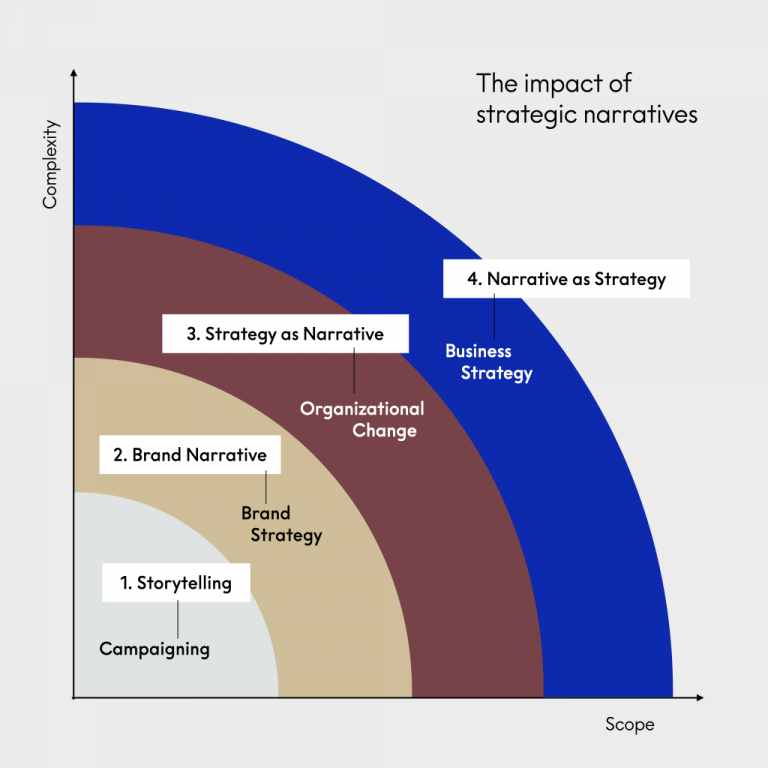
Narrative Strategy – The steep career of the narrative
We have been fascinated by the topic of narration for over ten years. As a management tool, as an understanding of strategy, as a means of aestheticization. With WAALD, we have been developing strategic narratives for a wide range of stakeholders in science, business and politics since 2012.

Listening is an integral part of our work. In well over 1,000 hours of interviews (we call this "storylistening"), we have heard the most fascinating things about people, industries and business models. In addition to the always exciting and sometimes moving anecdotes, a meta-insight has also emerged:
The use of narratives as a strategic tool is extremely diverse in different organizations and at the same time has made an amazing career.
The understanding of narratives and their conscious use vary. We have identified four ways in which narratives become effective. These characteristics can also be understood as stages of development - the more developed they are, the more lively and valuable the organization is.
Development stage 1: “Storytelling”
In this first stage, the organization - usually the marketing department - has understood this: Instead of just promoting offers via product features, stories need to be told. At this stage, narratives have a rather difficult time. They are reduced to something that is needed for communication, for advertising, as “packaging”. Corporate management and corporate strategy, as well as corporate communications and human resources, are completely detached from this.
Back in the 80s/90s, at the zenith of the advertising age, this understanding led to an extreme fictionalization of market communication. (Sometimes completely absurd) stories were staged in advertising - we all know them. The assumption was: the product doesn't really matter, it's the emotional story that counts, then people will buy anything. Unfortunately, this paradigm has also led to incredibly inferior products and pseudo-events. Above all, it has paved the way for the silo mentality that is still causing us major problems today. Corporate strategy was reduced to business, and advertising worlds were created in marketing, which in turn were decoupled from products. These advertising narratives were and are celebrated as successful “storytelling” by the advertising industry and the trade press. However, we are also observing that more and more companies that are successful in this first stage of development are using narratives for market communication that are based on what is actually experienced and are therefore perceived as authentic.
Use/effectiveness of narratives: at the level of product communication (campaigns)
Development stage 2: “Brand Narrative”
In this second stage, the company recognizes that stories need to be told not only in product communication, in sales, but that the product portfolio can be aggregated into something higher. It is about strategic brand management. Interestingly, military approaches were and still are used: for example, “positioning”. The market is seen as a battlefield. The best position for one's own “troops” is sought from the field commander's hill. Positioning crosses are used that already work with semantics, but shorten them badly or condense them in such a way that not much can remain of the richness of the offers. Mechanistic models and concepts are also frequently used - practiced in business administration, which attempts to emulate the natural sciences. However, this tends to use principles of order rather than means that can actually create valuable meaning.
Companies in the second stage of development, i.e. companies that understand brands as narratives and work with strategic brand narratives, overcome this disadvantage. Strategic brand narratives are stories that are activated through (communicative) action. The brand is not defined and controlled by steering wheels, positioning, etc., but is dynamically guided by narratives. The narrative clarifies: What does the brand want to achieve (purpose/general social mission)? What is holding the brand back (obstacles, opponents)? The entire narrative spans a wide range of communication measures that make the overall brand narrative comprehensible and tangible. Here it becomes clear: it is not about storytelling within an advertising measure, but about an initially abstract story that is told in concrete terms through individual communication measures.
However, this approach is still limited to marketing; the narrative is not yet relevant in other fields of activity of the organization
Use/effectiveness of narratives: in marketing/brand management
Development stage 3: "Strategy as narrative"
At this stage, organizations understand that everything they do on the market side is also directly relevant for their own employees. In other words, the distance between what marketing does “out there in the world” and what is said in the “internal all-hands meeting” is reduced. The old silos, in which each functional area had worked in its own logic, are becoming coupled again. Corporate strategy is translated into narratives that are connectable because they are understood by people. What's more, narratives create docking points for participation that are much more valuable than undirected participation. The organizations in the third stage of development have understood this: Corporate strategy and business model, market communication and internal communication must be managed in a largely congruent manner. Because an organization is made up of countless narratives, strategic narratives are needed to manage the organization. If companies want to change, transformation narratives help to make valuable change possible. Organizations at this stage of development are aware that internal change is also needed to drive change in society as a whole.
Use/effectiveness of narratives: human resources, organizational development, corporate communications, marketing
Development stage 4: "Narrative as a strategy"
This final stage is achieved by successful organizations partly consciously and partly unconsciously. This is where the organization understands that if the entire company, the entire business model, is managed according to narrative principles, the organization will be led to success. This is where the “Competitive Advantage” becomes the “Narrative Advantage”. Corporate strategy is not just an Excel spreadsheet, but strategic narratives become the basis of business models. Every business model needs a narrative check. What's more, tomorrow's markets and products are not just calculated and accounted for, but developed in such a way that they create a story. An overall social mission (purpose narrative) is lived in the company and all actions serve to fulfill this mission. The organization sees itself as a protagonist in a story. Entrepreneurial activity leads to new episodes, twists and turns and exciting moments that can be docked onto people and the media.
Internal silos within the organization are completely merged. Employees understand best why they are part of the organization and that they are contributing to a greater cause. These organizations take a completely different approach to risk management: risk avoidance becomes risk.
In this stage, narrative becomes strategy. The difference to level 3: Strategy is not understood as something that now has to be translated into a story, but the organization is understood as the protagonist of a story. The world is the stage. People and media are spectators and players.
Use/effectiveness of narratives: Board, R&D and all other functional areas of the organization
How narrative is your organization?